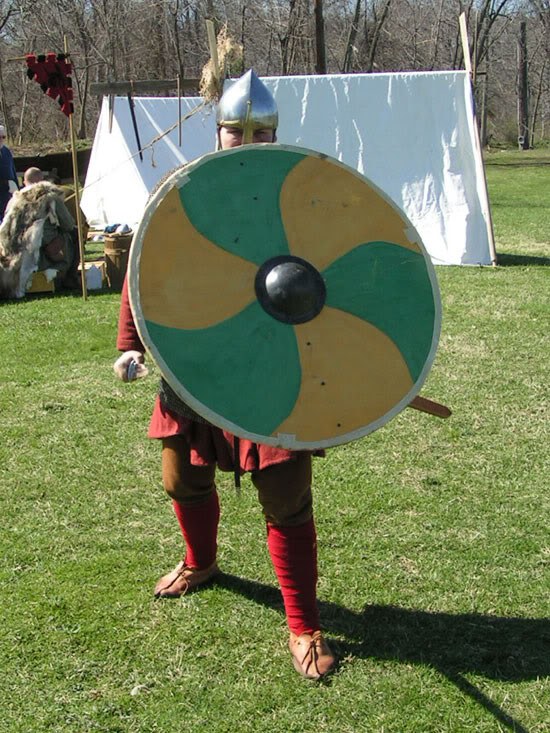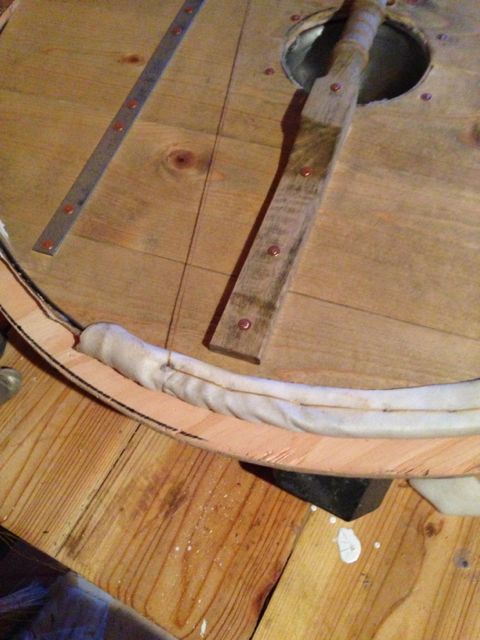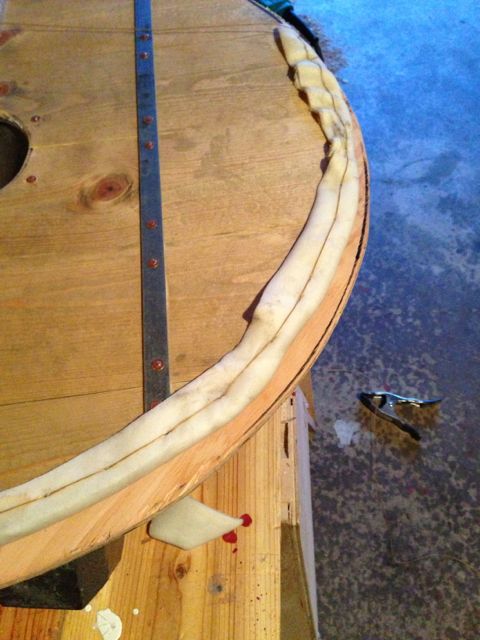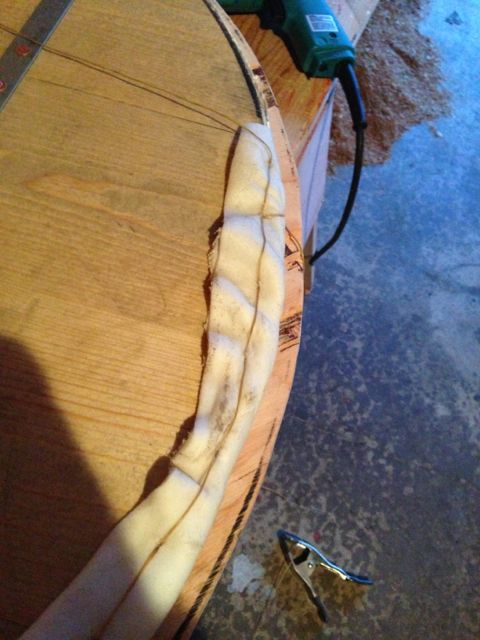| Author |
Message |
|
Sean Eaton
Location: Vancouver, WA Joined: 04 Jun 2013
Posts: 16
|
 Posted: Tue 11 Jun, 2013 7:40 pm Post subject: Rawhide for edging viking shield, where can it be acquired? Posted: Tue 11 Jun, 2013 7:40 pm Post subject: Rawhide for edging viking shield, where can it be acquired? |
 |
|
I have used leather in the past and cut it in 3" strips to edge the circumference of the shield... But I find it a bit cumbersome and want to get a little more historical by using rawhide, but the pieces of rawhide at tandy seem pretty expensive for what you get (much smaller than the sheet of leather). Am I missing something here? I've never used rawhide before, so I don't know if it will expand a bunch when it is wet or what. Looking for answers on how to apply it mostly, and where you all find sells it pretty cheap is reasonably larger strips/sheets so I don't have 5 different pieces wrapping around a shield.
Thanks in advance!
Sean
|
|
   |
 |
|
Matthew Harrington
|
 Posted: Tue 11 Jun, 2013 8:36 pm Post subject: Posted: Tue 11 Jun, 2013 8:36 pm Post subject: |
 |
|
|
This might sound weird, but go to a pet store or the pet isle in your local department store and get rawhide rolls/strips soak them in water, then attach them to the side of your shield. After it dries it's binds to the shield and it's obviously still rawhide and provides the protection you want. I've done this for two of my viking age shields.
|
|
  |
 |
|
Sean Eaton
Location: Vancouver, WA Joined: 04 Jun 2013
Posts: 16
|
 Posted: Tue 11 Jun, 2013 8:41 pm Post subject: Posted: Tue 11 Jun, 2013 8:41 pm Post subject: |
 |
|
I did think of that, lol. About how long do the pieces unroll to? Really what I mean is how many of them should I buy?
Thanks 
|
|
   |
 |
Jimi Edmonds

|
 Posted: Wed 12 Jun, 2013 12:35 am Post subject: Posted: Wed 12 Jun, 2013 12:35 am Post subject: |
 |
|
I used around 2.5 large plain dog chews (dried rawhide in the shape of a dog bone), and that went around my heater shield. The dog chews I used had one or two longish strips that were about an inch to two inches wide (it varied) with smaller retangler pieces wrapped inside which were used to go over the joined sections of longer rawhide.
I did end up adding extra strips along the top and right edge (to take more blows) and pinned it with 15mm black carpet tacks.
It holds up well, although the rawhide can dry quite sharp where you join it so its a good idea to cover the joins with another piece. I found that it was easy to stretch the rawhide, though you don't want it to stretched!
Also sometimes the long strips are fatter than others so its a good idea to add the fatter strips to where the most blows come in at.
I don't have my shield/s with me to give a measurement, though I'd say you'd need at least 3 maybe 4 large chews to go round your shield. I soaked them over night..
I hope this helps..
Oh yes I got my chews from the supermarket..and the longest strips were about the length of my elbow to my fingers, but as I wrote it varies..
|
|
  |
 |
|
Christopher Treichel
Location: Metro D.C. Joined: 14 Jan 2010
Posts: 268
|
 Posted: Wed 12 Jun, 2013 5:31 am Post subject: Posted: Wed 12 Jun, 2013 5:31 am Post subject: |
 |
|
There are some vendors who will just sell you rawhide in lengths... A lot cheaper and easier to deal with than dog chew toys or having to buy $100 worth of rawhide for one project
http://www.zackwhite.com/Rawhide_c_283.html
|
|
  |
 |
|
Philip Melhop
Location: Wokingham, Berkshire, UK Joined: 24 May 2008
Posts: 132
|
 Posted: Wed 12 Jun, 2013 6:53 am Post subject: Posted: Wed 12 Jun, 2013 6:53 am Post subject: |
 |
|
Hi Sean
leather doesn't really last as shield edging and rawhide is definately the way to go.
-Use the large size doggie chews, get unbleached ones if possible they are much stronger. Two or three should be plenty
- Soak them overnight in COLD water, they will then unwrap quite nicely. Let them drain and wrap in a wet towel to maintain workability
- the largest pieces are way too wide for shield edging so you can cut them into the correct width using a stanley knife or similar.
- decide how you are going to attach the edging, sewn, tacked, glue etc and start , you will need to stretch the rawhide as you work along each piece. I usually use large spring paper clips and just slide them along as I secure the edging.
- Overlap the ends rather than butting the pieces together. The rawhide shrinks quite a bit and if the pieces are butted together you end up with gaps to cover. I used to overlap so the joint faces down .
- If the rawhide dries out and gets stiff just soak it afor a while and you are back in business.
Phil
|
|
  |
 |
Robert P. Wimmers
Industry Professional

Location: Dieren, The Netherlands Joined: 24 Nov 2008
Posts: 44
|
 Posted: Sun 16 Jun, 2013 3:30 am Post subject: Posted: Sun 16 Jun, 2013 3:30 am Post subject: |
 |
|
If I may add a suugestion. I have found that after the rawhide has dried on the shield, one can take a drill and make all the small holes needed for a nice, fine stitching using waxed linnen thread. It goes through rawhide, wood and rawhide in one go. A shoemaker will have the correct kind of thread in stock for you. Using two needles, it works fine. Do knot it inside the holes occasionaly, so if the lacing gets cut, it does not unravel any further then a knot. This is how I put the edging on 4 Roman oval shield.
Good luck.
|
|
  |
 |
|
Philip Melhop
Location: Wokingham, Berkshire, UK Joined: 24 May 2008
Posts: 132
|
 Posted: Sun 16 Jun, 2013 3:42 am Post subject: Posted: Sun 16 Jun, 2013 3:42 am Post subject: |
 |
|
I always stitch the rawhide when wet, and I have used everything from heavy linen thread to fishing line. It is a good idea to tie off the thread every few inches though. I always used a simple running stitch, although I have seen a rough saddle stich used too. Whatever method is used the rawhide must be secure before it begins to dry, it contracts with an amazing amount of force.
Phil
|
|
  |
 |
James Barker

Location: Ashburn VA Joined: 20 Apr 2005
Posts: 365
|
 Posted: Sun 16 Jun, 2013 5:39 am Post subject: Posted: Sun 16 Jun, 2013 5:39 am Post subject: |
 |
|
My first shield I used a sheet from a leather store online and it covered a 32 inch round shield no issue (that is a huge round shield BTW) I got a giant dog chew at Tractor Supply store for about $8 and it will cover the same amount when I redo my shield this year.
As a matter of perspective I am 6'3" tall:

James Barker
Historic Life http://www.historiclife.com/index.html
Archer in La Belle Compagnie http://www.labelle.org/
|
|
   |
 |
|
Sean Eaton
Location: Vancouver, WA Joined: 04 Jun 2013
Posts: 16
|
 Posted: Mon 17 Jun, 2013 9:09 pm Post subject: Posted: Mon 17 Jun, 2013 9:09 pm Post subject: |
 |
|
So when the rawhide is wet, the stitching, I assume, would go right through it with a needle attached, right? Before when I used strips of leather I would clamp it around the edges and drill holes through the shield/leather so there is a hole through it all then rivet it with copper nails/burrs. I had planned to do this same thing with the rawhide, but the stitching seems like a better way, but what would the process be for that? I imagine it goes something like this:
soak rawhide, cut into desired strips
wrap around the circumference and start stitching it together
stitch other side
tighten
dry
Am I missing something here?
By the way, great looking shield James! It turned out well.
|
|
   |
 |
|
Philip Melhop
Location: Wokingham, Berkshire, UK Joined: 24 May 2008
Posts: 132
|
 Posted: Tue 18 Jun, 2013 2:07 am Post subject: Posted: Tue 18 Jun, 2013 2:07 am Post subject: |
 |
|
Hi Sean
i will try to give you the general idea of how I have done this. It is one of those things you could be shown in about 5 minute but take a lot of words to describe. 
Assuming you have your rawhide soaked and cut into strips the correct width.
1 - secure the end of the first strip, I use a heavy duty stapler. Make sure the strip is centalised on the shield edge and you have enough rawhide on each side to be able to stitch trough.
2 - stretch the rawhide out an secure in a couple of places with clamps of some sort. I use large size paper clips called Bulldog clips here in the UK. You will need to slide these along the shield edge as you stitch.
3 - Sart by drilling a couple of holes through the rawhide, the shield board and the rawhide on the other side. I use a small piece of plywood to hold the back side rawhide down flat and prevent injury to my hand. The dril diameter is really dependant on what needle and thread you use. Normally I would use a 2 -3 mm drill bit, but a bit of trail and error on a scrap piece will soon show you what works for you.
4- put in your first couple of stitches, it pays to go through the first two holes a couple of times and tie off your thread securely as you will be pulling it very tight..
5 - Work around the rawhide, driling 5 or 6 holes and stitching through them, each time you will need to adjust your temporary clamps by sliding them around the shield edge to keep the rawhide nice and tight. I always use a simple running stitch, ie just push the needle through one drilled hole and back through th next one, this is quick and easy but you must be using decent heavy thread. For a running stitch you will need thread about 2 1/2 times longer than the piece you are stitching. I always just drilled the holes by eye, no measuring, after a little practice it is quite easy to make the whole thing look neat.
6 - as you approach the end of the first piece of rawhide tie the thread off about 25mm(1inch) from the end but don't cut it, you need to stitch over into the next piece.
7 - place you next piece of rawhide on the shield, under or over the end of the first piece, then staple through to secure, refix your clamps close to the join , drill through all the layers and stitch through, pulling very tight. Then continue drilling, stitching and moving the clamps as before. If you overlap as described there will be no gaps to cover.
8 - when you have edged right round the shield end with the final joint overlaping the initial piece of rawhide, carefully make the last few stitches through the same holes(no need to drill more) and tie off. Set shield aside to dry, the rawhide will shrink and tighten everything up. This usually take a couple of days.
9 - Keep the rawhide strips nice and damp, if they start to get stiff cover with a damp cloth or even re-soak .Make sure the stitches and edging are kept as tight as possible as you sew along, a few stitches at a time is the way to go. The finished edge looks good, is very durable for re-enactment style combat with blunts, and is easy to repair. If the edging does get damaged, simply cut the stitches, remove the damaged piece and stitch in a new one remembering to overlap the ends.
|
|
  |
 |
|
Sean Eaton
Location: Vancouver, WA Joined: 04 Jun 2013
Posts: 16
|
 Posted: Tue 18 Jun, 2013 8:33 am Post subject: Posted: Tue 18 Jun, 2013 8:33 am Post subject: |
 |
|
Wow, wonderful write-up. Thank you very much everyone, all my questions have been answered 
|
|
   |
 |
James Barker

Location: Ashburn VA Joined: 20 Apr 2005
Posts: 365
|
 Posted: Tue 18 Jun, 2013 12:10 pm Post subject: Posted: Tue 18 Jun, 2013 12:10 pm Post subject: |
 |
|
I did nearly the same thing. Wet the rawhide, cut strips, applied it to the edge, clamped, drilled, stitched in place.
I used 6 ply linen thread that I waxed and I did saddle stitching all the way around.
James Barker
Historic Life http://www.historiclife.com/index.html
Archer in La Belle Compagnie http://www.labelle.org/
|
|
   |
 |
|
Sean Eaton
Location: Vancouver, WA Joined: 04 Jun 2013
Posts: 16
|
 Posted: Tue 18 Jun, 2013 3:28 pm Post subject: Posted: Tue 18 Jun, 2013 3:28 pm Post subject: |
 |
|
|
I have a roll of artificial sinew from tandy, any thoughts on using that? It's already waxed, so bonus there.
|
|
   |
 |
Robin Smith

|
 Posted: Tue 18 Jun, 2013 3:59 pm Post subject: Posted: Tue 18 Jun, 2013 3:59 pm Post subject: |
 |
|
Is there any evidence at all for such edging on medieval European shields? I thought it was a reenactorism...
A furore Normannorum libera nos, Domine
|
|
   |
 |
|
Sean Eaton
Location: Vancouver, WA Joined: 04 Jun 2013
Posts: 16
|
|
   |
 |
|
Sean Eaton
Location: Vancouver, WA Joined: 04 Jun 2013
Posts: 16
|
 Posted: Tue 18 Jun, 2013 5:02 pm Post subject: Posted: Tue 18 Jun, 2013 5:02 pm Post subject: |
 |
|
|
One more thing-- the spiral patterns. I've done mine clockwise, and I've seen people do them both ways. Does it matter?
|
|
   |
 |
Robin Smith

|
 Posted: Tue 18 Jun, 2013 5:44 pm Post subject: Posted: Tue 18 Jun, 2013 5:44 pm Post subject: |
 |
|
Does it call for an edging though in the sagas or laws? Hurstwic makes no mention of such on his site, and only references the edge holes and clamps. I suspect the holes or clamps along the edge were to hold on a facing, not an edging. Given that these shields were plank constructed, full facing would add far more to the integrity than a simple edging and where the facing lapped over the edge it would create a sort of edging.
Believe me, I would love to find support for the practice, which is why I ask. However, so far I haven't seen anything other than modern speculation 
A furore Normannorum libera nos, Domine
|
|
   |
 |
James Barker

Location: Ashburn VA Joined: 20 Apr 2005
Posts: 365
|
 Posted: Wed 19 Jun, 2013 7:25 am Post subject: Posted: Wed 19 Jun, 2013 7:25 am Post subject: |
 |
|
| Robin Smith wrote: | | Is there any evidence at all for such edging on medieval European shields? I thought it was a reenactorism... |
Medieval? I don't know of any medieval examples but Viking age there is evidence. Besides what they written accounts say the plank remains have holes drilled through them at the edge, Gokstad is a prime example, so either a rawhide edge or the hide stretched over the face to the back had to be sewn down. Some shields have a few metal edge clamps attached, Birka has 12 finds, Valsgarade, Lindholm, and Orkney all have a find with metal edge clamps. Iconography of that era such as helmet decorations and sculptures show a rim on the shields edges; the picture stones from 7-8th century Gotland and the tapestry fragments in Oseberg Norway about 834AD show rims.
Medieval shield remains in Der mittelalterliche Reiterschild from 1100 to 1350 are all hides stretch over the front to the back and nailed on in some fashion. No special edge.
James Barker
Historic Life http://www.historiclife.com/index.html
Archer in La Belle Compagnie http://www.labelle.org/
|
|
   |
 |
|
Sean Eaton
Location: Vancouver, WA Joined: 04 Jun 2013
Posts: 16
|
 Posted: Wed 19 Jun, 2013 9:06 pm Post subject: Posted: Wed 19 Jun, 2013 9:06 pm Post subject: |
 |
|
So I'm having a hell of a time applying this rawhide to my latest shield... I couldn't cut it straight, It's being uncooperative when trying to drill holes and stitch, and I'm generally just hating every minute of it. Strips of 3" leather was so much easier. Here are some pics, I doubt you'll be able to tell what I'm doing wrong, but at least you can see how awful it looks! lol. Any more tips would be appreciated; I'm using an 8 hour soaked dog bone as the rawhide. No success. laugh away. I just can't seem to get it tight enough or even at all. This is one of the most frustrating things I've ever done, and I've been in the military!
 Attachment: 54.79 KB Attachment: 54.79 KB

 Attachment: 58.06 KB Attachment: 58.06 KB

 Attachment: 56.02 KB Attachment: 56.02 KB

|
|
   |
 |
|
|

